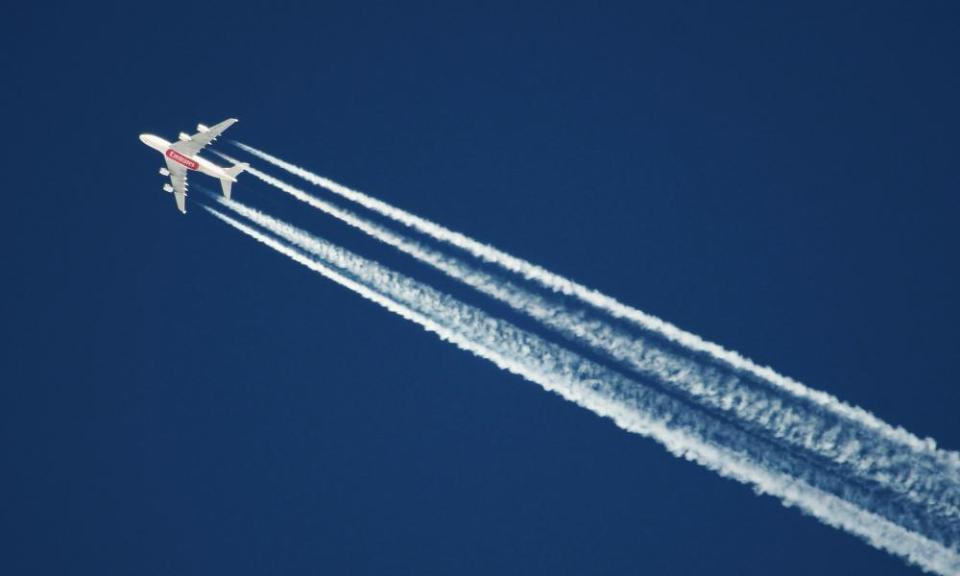Can the aviation industry really go carbon neutral by 2050?

Like all great pledges, it is just the right side of implausible. The UK aviation sector this week committed to making flying “net zero” by 2050, wiping out its carbon emissions despite taking more than 100 million extra passengers into the air each year.
At a celebratory event in London, the bosses of airports, airlines and aircraft manufacturers queued to scrawl their signatures on a giant Net Zero pledge card from the Sustainable Aviation [SA] campaign.
Related: UK air industry sets zero carbon target despite 70% more flights
Greenpeace described it as greenwash. But aviation figures insist the ambition is genuine. John Holland-Kaye, the Heathrow airport chief executive, says: “I imagine it’s like it is for alcoholics. The first step is to admit we have a problem – and then do something about it. I’m not sure what the 10 points on the AA [Alcoholics Anonymous] programme are, but you can find the equivalent in the SA roadmap.”
The steps certainly involve a leap of faith, in future fuels and aircraft technology, and human capacity to endlessly offset emissions. Just how does a growing industry plan to reduce its annual footprint from just over 36m tonnes of CO2 to net zero in three decades time?
Solution: newer, more efficient planes
Saving: 23.5m tonnes CO2
Aircraft such as Boeing’s 787 or Airbus’s A350 already emit significantly less than the older jets they are replacing, through lighter materials and more efficient engines. Sustainable Aviation anticipates that emissions will drop around 30% on routes operated by Boeing 747 jumbos as they are phased out within a decade. The next iteration of the manufacturers’ short-haul workhorses are supposed to be 10-15% more efficient – demonstrated with the A320neo superseding A320s, although the disastrous introduction of the grounded Boeing 737 Max has delayed airline plans to replace older 737s.
Altogether different types of propulsion will be in operation by the 2030s, manufacturers believe. But while new electric planes could revolutionise regional flights, and hybrid-electric could manage short-haul flying, their contribution to cutting UK emissions – about 65% of which hail from flights of more than 1,000 miles – will be comparatively minor by 2050, SA admits.

Solution: synthetic and sustainable jet fuel
Saving: 14.4m tonnes CO2
“We’re not going to be electrifying a London-Singapore A380 for a long time, if ever,” says Paul Stein, chief technology officer of aircraft engine maker Rolls-Royce. “But sustainable fuels can work on the engines we have today, and the concept has been proved.”
Creating the necessary volume is the tricky bit. Hopes have been pinned on new schemes, such as the new British Airways-backed plant to create jet fuel from household waste. Stein says Rolls-Royce has been exploring whether a small modular nuclear reactor could be used in a synthetic fuel plant, making hydrocarbons in a way that would reduce CO2 to balance the emissions produced in flight.
“Right now we’re in analysis phase – understanding the economics … But what we’re going to see over the next 10 to 20 years is a lot of innovation and energy directed at creating sustainable aviation fuel.”
Solution: flying straighter and cleaner
Saving: 3.1m tonnes CO2
Progress in coordinating European airspace and air traffic control has been slow. But with better use of airspace, and coordinated flight paths, planes could be guided more efficiently from take-off to landing. The UK is in the midst of redesigning its airspace to help create better paths. More efficient operations, such as eliminating stacking, would help aircraft carry and burn less fuel.
Solution: offsetting emissions
Saving: 25.8m tonnes Co2
Environmental groups question the adequacy of offsetting – but the roadmap relies on it to account for more than a third of aviation’s projected emissions. Jonathan Counsell, head of sustainability at British Airways’ owner IAG, says: “We think that we can get to net zero without it – but not by 2050. This is a transitional measure.” The scepticism about offsetting means, Counsell admits, that any schemes have to be high-quality, independently verified and end in actual, additional carbon removal. For now, offsetting means reforestation or restoration of peatland bogs that absorb CO2 from the atmosphere; later, potentially, investment in new carbon capture and storage technologies.
Solution: pay more to fly, cut demand
Saving: 4.3m tonnes CO2
In an industry run by accountants, some jiggery-pokery was perhaps inevitable: emissions are “saved” as the 70% rise in passengers by 2050 is, in fact, slightly lower than the Department of Transport’s growth forecast growth.
“We will have to pay more to fly,” says Holland-Kaye. Sustainable fuels are more expensive, and the carbon price is expected to rise tenfold, he says. The price of all the offsetting that the industry will rely on will be passed on to consumers through higher fares, constraining demand.
So can this work? The industry urgently wants to present an alternative vision to the growing backlash against flying. Stein says: “Flying connects the world – it is a force for good in transporting people and goods, making sure our cultures have great levels of understanding.”
As an engineer, he says, he is optimistic that emissions can be brought down sooner than the roadmap pledge: “We have the engineering tools to do it; we need the will, and government help.”

 Yahoo Finance
Yahoo Finance 